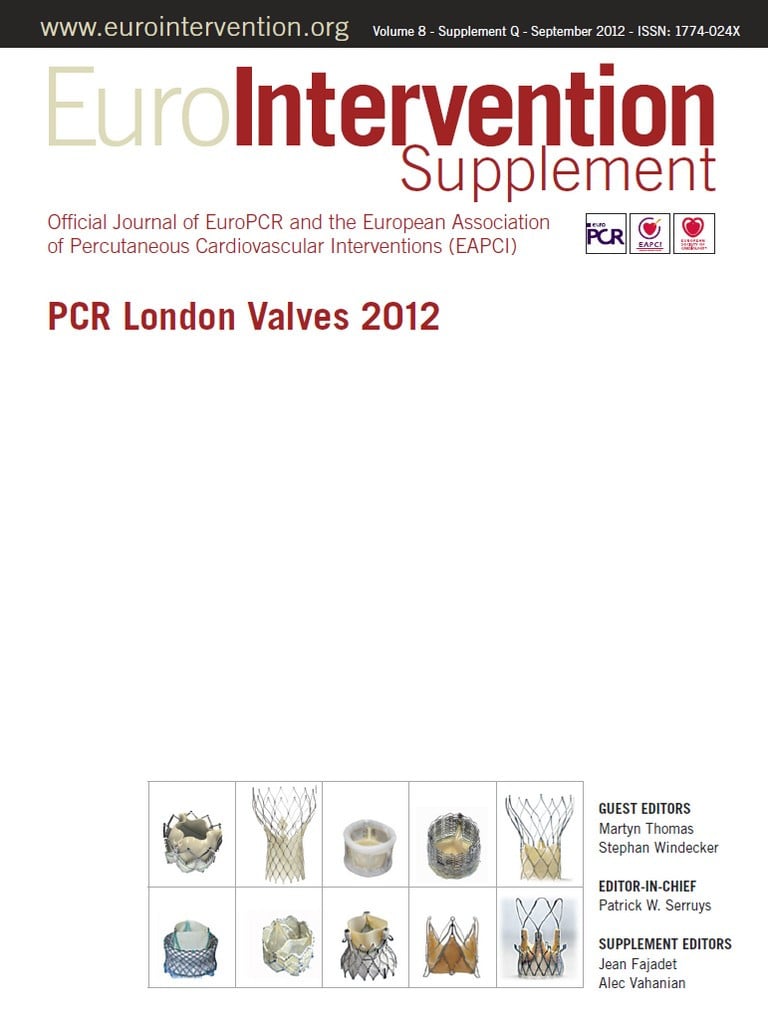![]()
Single and multicentre TAVI registries
Percutaneous transfemoral transcatheter aortic valve implantation (pTAVI): a single-centre experience comparing general with local anaesthesia
Aims: Transcatheter aortic valve implantation (TAVI) is the treatment of choice for high-risk patients with aortic stenosis. Percutaneous transfemoral vascular access is the preferred and least invasive approach (pTAVI) and may be performed under local anaesthetic (LA) in suitable patients. Other vascular approaches are surgical (sTAVI) and require general anaesthesia (GA). We aim to describe the vascular approaches and modes of anaesthesia used in our CoreValve TAVI programme and evaluate, as well, the vascular outcomes of pTAVI using the Prostar pre-closure device.
Methods and results: Consecutive TAVI procedures (n=106) between October 2008 and April 2012 were analysed and data pertaining to baseline characteristics, delivery approaches, anaesthesia and hospital stay were examined. All patients who had TAVI via the percutaneous femoral approach were specifically asked about new claudication symptoms on follow-up and those who had successful device (Prostar) closure of femoral arteriotomy had quantitative assessment of femoral angiographic stenosis (QFA). Vascular access was assessed routinely by aorto-ilio-femoral angiography; vessel diameter (minimum 6 mm), tortuosity and calcification were the key determinants of suitability. Each case was reviewed by a multidisciplinary team (MDT) involving cardiologists, surgeons and anaesthetists. The transfemoral approach was preferred wherever appropriate. LA was considered for all transfemoral cases taking into account the body habitus and patient psychology. The delivery approach was transfemoral in 84 (79%), subclavian in 17 (16%) and direct aortic in five (5%) cases. Of the 84 transfemoral cases 47 (56%) were performed with GA and the remaining 37 (44%) under LA. The mean logistic EuroSCORE in the GA group (22%) was significantly higher than in the LA group (16%) (p=0.019). Other variables like age, gender and body mass index (BMI) were comparable as was the duration of hospital stay (11.3 [GA] vs. 9.8 [LA]). Closure of the femoral arteriotomy using the Prostar device was successful in all but five cases (79/84, 94%). In one case, emergency bypass grafting was necessitated by avulsion of the iliac artery during removal of the sheath. QFA was performed in 69 of these 79 patients. This revealed a mean angiographic stenosis of 30±17% (2-72%). Greater than 50% stenosis was found in 13 (13/69; 33%) patients. Importantly however, there was no incidence of new claudication on follow-up (median 17 months).
Conclusions: Our data suggest that in selected patients determined by an MDT, pTAVI under local anaesthesia is feasible, safe and probably desirable, particularly in the older patients. Surprisingly, lower logistic EuroSCORE and not BMI was a significant factor favouring the use of local anaesthesia. The percutaneous transfemoral approach and subsequent pre-closure using the Prostar device appear to have satisfactory acute and long-term vascular outcomes even in patients who had a significant degree of angiographic stenosis after device closure.

